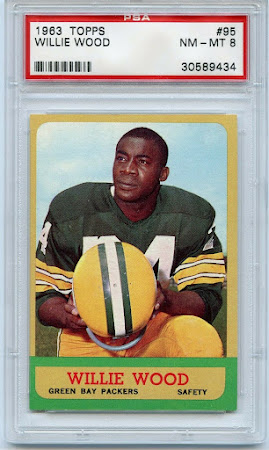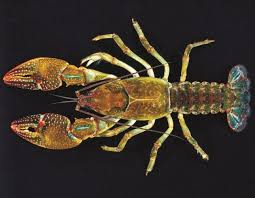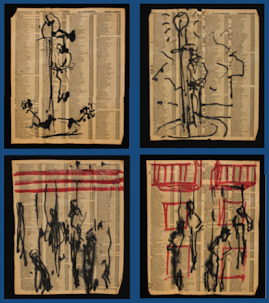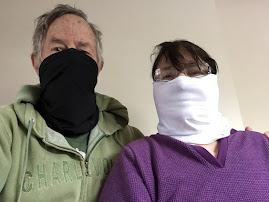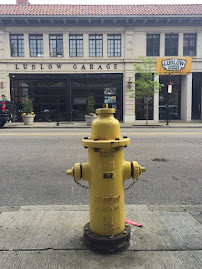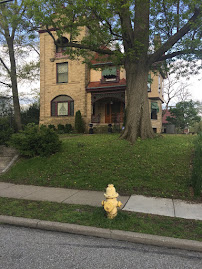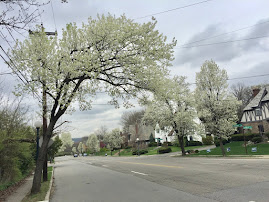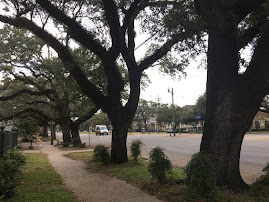
Vic reads to Dave and Steve (circa 1943)
Dear George,
This file is the second of two cumulative archives of “Vic’s Photos” that have previously appeared in the righthand column of this blog. “Vic”, of course, is my dad, V.A.L. Jr., who was an excellent amateur photographer and who documented our family’s world from the late 30’s to the late 50’s and beyond. These photos have been changed every week since July 2009, and, because they aren’t automatically saved on the blog, I’ve decided to store the old ones here for a new viewer’s potential interest. Updated additions will continue to be made from time to time as photos are posted. My brother Peter restored and shared with our family these images from Vic’s original negatives, and his project is the source of all of the photos contained here.
Love,
Dave

FOUR SIBLINGS ON THE ICE
The Menominee River dominated our growing up. In the winter it enabled us to cross over to Pig Island by foot, or explore along the river’s bank to the east and the west. We could sled, skate, and ski on the river, build snow forts, chop holes in the ice, and do ice fishing (though we rarely did that). When the ice went out on “Chinese Bells Day” we stepped into the river in hip-high waders and retrieved flotsam and jetsom treasures with bamboo fishing poles. From the left: Peter, Dave, Vicki, Steve.

DAVE WITH MICROSCOPE
My parents gave me a microscope in high school to foster my nascent scientific interests, and I soon became fascinated with growing protozoa in yeast-filled water. I took the microscope with me to Antioch College and created a colony of tiny creatures there, but it smelled so bad that my roommate demanded that I move the bottles out on the fire escape. I think we still have the microscope somewhere up in our crowded attic. Maybe I will get it out again.

UNCLE RALPH AND AUNT MARTHA
Martha was my dad’s sister and the youngest of four siblings in their family. Ralph, her husband, helped run the Marinette Drugstore along with pharmacist Clarence Nelson. They and their kids, Ann and John, lived at Pine Beach in Marinette with my grandfather, V.A. Sr., and we were regular visitors at their household. My brothers, sister, and I all worked in our teenage years for Uncle Ralph who was a kind and jovial boss. In our adult years Vicki and I visited Martha each year when we were home for family reunions, and she was a fount of genealogical information about our family.

DORIS WITH THREE KIDS AT OUR WEDDING
My family drove the 600 miles from Menominee to Yellow Springs for Katja and my August 1960 wedding. They stayed at the Antioch Inn, and my parents entertained us all at the rehearsal dinner at the King Cole restaurant in Dayton. Steve was my best man. Katja and I were overjoyed to be getting married after a turbulent senior year.

STEVE IN VARSITY SWEATER
Steve was the best athlete in our family. Coach Noonan recruited him for the varsity basketball team when he was only a freshman, an unprecedented event, and he was a four-year letterman in basketball, as well as the top player on the golf team. My brother Peter played football, and I was on the tennis team. In an era of no girls’ sports, my sister Vicki was a cheerleader (at least for a while).

DAVID AND DORIS AT CARDS
My parents were devoted bridge players, and they decided to teach the game to Katja and I as newlyweds. Bridge seemed to demand an excellent memory and inordinate concentration, and we didn’t take to it. Instead we stuck to gin rummy, hearts, and canasta.

FAMILY PHOTO WITH KATJA
Katja was very attached to our family from her very first visit to Menominee in 1957, and they in turn loved her. This photo was taken in summer 1961, a year after we got married, and it’s the first annual family photo in which Katja was a family member. We visited Menominee each summer and each Christmas for many years afterwards.

FAMILY VISIT AT YMCA CAMP
Much to my horror, I was sent off to YMCA camp each summer in my mid-childhood. My main recollection is kids pulling wings off butterflies and paralyzing frogs by smacking them down on the water on their bellies. The middle Sunday of camp sessions was a family visiting day, and I would beg to be taken home (to no avail).

FIRST DAY OF KINDERGARTEN
I was never any good at going off to new places on my own as a child. Here my mom is delivering me to Boswell School on the first day of kindergarten. This photo reeks of terror.

DORIS AND GRACE WITH BABIES
That’s my mom and me and Grace and Sally Fernstrum. Our families lived in the upstairs and downstairs apartments of a big white house on Ogden Avenue, just west of the Interstate Bridge. Sally was my first friend in life, and we went to kindergarten at Boswell School together. Our family then moved to Sheridan Road, but Sally and I resumed our friendship in our teenage years when we were members of the same crowd. Nowadays we see one another at high school reunions every five years or so.

VIKINGS
Given a small town in a rural environment with limited community events, my parents and their friends were beyond creative in the many social events that they generated for their amusement. Theme parties and costume parties were the name of the day. Here are Doris and Vic who one could easily mistake for authentic Vikings.

COWBOY STEVE
This is my brother Steve in his cowboy outfit, probably age 8 or 9. Cowboys were s bigger deal in our day than they were a generation or two later, probably due to a steady diet of Saturday afternoon matinees. Playing cowboys and Indians in the back yard was one of our major pastimes. We’d ride imaginary horses, form posses and chase the bad guys, shoot our capguns, and make a lot of noise.

GOING TO THE PROM
The boys rented tuxes for the prom, and the girls rented ballgowns. The boys bought a corsage for their date’s wrist or dress and a boutiniere for themselves. Much to my embarrassment, my father recorded this event for posterity, showing up with his camera at my date Carol G’s house. This photo was from the Menominee High junior prom in 1954.

V.A. SR., VICKI, AND PETER
This is our grandfather, V.A.L. Sr., with his grandchildren Vicki and Peter, taken at river house. V.A. was a kind, gentle man who was close to his grandchildren. He had a one-room cabin built on our property and lived there for a year a while until he moved to Pine Beach to live with his daughter Martha and her husband Ralph. Steven took over the cabin several years later and turned it into a poker-playing den of iniquity. V.A. had a special bond with Peter, and they spent many hours at the workbench in the garage, carrying out one fix-it project after another.

VICKI AND KEVIN
Vicki and Kevin (Kiera) look to be about 11 or 12 in this photo. They were the very closest of friends, and Vicki was practically a member of the O’Hara family, Kiera was born on the Fourth of July and was nicknamed Firecracker by friends and family, at least in part because of her passionate temperament. Inspired by her chum, Vicki decided that she wanted to be a Catholic, and, in fact, her life aim at the time was to become a nun. Our parents told her she couldn’t do that, and that created much distress and conflict. I haven’t heard anything about it for a very long time.

RIVER HOUSE AT DUSK
For those who are familiar with river house, this photo is likely to be perplexing. What, for example, is that door on the right side of the center section of the house? The answer: this negative was printed backwards, and those French doors, shown here on the east side of the house, were really on the west side. Judging from the size of the small evergreens in the front yard, this picture was taken early in river house’s history in the 1940’s. Dusk was a special time in our childhood, the winding down of a day of outdoor play, and a time to swat mosquitoes and catch fireflies in a Mason jar.

DAVE’S 10TH BIRTHDAY
This is me getting ready to blow out the candles on my tenth birthday cake with assistance from my six-year-old brother Steven. While Steve, Vicki, and our mom all had birthdays in late February, Peter’s and mine were in the summer, and so we got to celebrate with outdoor play and swimming in the river. Age ten was one of those big round-number birthdays that was a milestone of growing up – moving on to fifth grade and finishing a first year of living in the country on the river.

DORIS, JEAN, AND PUFF AT FARM
This is my mom, Doris, and our close family friend, Jean Worth, sitting on the bridge over the creek at our family property at Farm. Jean edited the Menominee Herald-Leader, then moved on to the Escanaba newspaper, and was the foremost historian of the Upper Peninsula. He was a wonderful story-teller, had a great sense of humor, and my parents were very close to him. The dog in the photo is Puff, loved also by my parents, and a gift from Steve and Margie who named him after the drug-inspired tune of the sixties, Puff the Magic Dragon.

THE GOLFERS
This is my brother Steve (right) and two of his close friends, Peter Venema (left), and Tom Kuber (middle), at the Riverside Country Club in about 1959. I got to chat with Peter Venema in Menominee about ten years ago when he was doing a bird-watching project in Menominee County, and several years before that we met up with Tom Kuber who was engaged in large-scale economic development projects in Milwaukee and the Twin Cities. Growing up, Steve had a close and spirited friendship group, all of whom remained good friends throughout adulthood.

PETER, AGE 6
I am going to guess that this is Peter L’s sixth birthday (since he’s given us a signal with his fingers). The cowboy gun holsters might be part of a birthday present as well. Shaped by World War II, our childhood was filled with toy guns and gun play: cowboys and Indians, cops and robbers, soldiers in combat. Those were the most exciting toys of our young years, and they were successful socialization devices for fostering male aggression, militarism, and a criminal mindset.

ON TOP OF THE GIANT STUMP
This is me (about age 12) and Steve (about age 8), on a giant stump that probably had been pulled from the Menominee River. As a major conduit for the late nineteenth and early twentieth-century logging industry in northern Michigan and Wisconsin, the river was filled with stumps and deadheads. We would occasionally row across the river to the Channel and bring stumps home to make tables and other decorative projects. I can’t imagine ever seeing a stump this big (though obviously I did).

SWIMMERS
Peter looks about 6, Vicki about 4 (circa 1951), and they are in the front yard at river house. Since our lawn was on the banks of the Menominee River, offering an ever-present swimming site, I’m not sure why we even needed a plastic pool. However, the children look pleased about it.

DORIS, DAVID, AND LAMB
I look about two years old and, of course, have no recollection of anything from this age, much less petting a baby lamb. Vic took many idyllic pictures of my mother with me and my siblings, and I can’t help but wonder how representative they are. Oh well, not to worry, I should just enjoy this fine scene.
G-mail Comments
Hi David, Loved your rotating 'archive' - some of those pictures I've never seen (eg you and Doris and the lamb - what a fine Easter Card that would make). I'm searching for some nice portraits (close-ups) of both Vic and Doris – they seem kind of rare. If you come across anything let me know - Love, Sis
-Gayle C-L (8-17): David. Very Nice. Hope all us well. LOL. G



























































